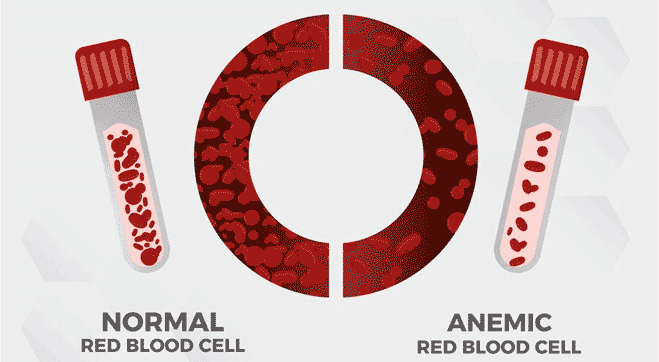Introduction to Sickle Cell Anemia
Sickle Cell Disease is an inherited blood disorder characterized by the production of hemoglobin, which is an abnormal form of hemoglobin called hemoglobin S. Hemoglobin is the protein in red blood cells that carries oxygen from the lungs to the rest of the body. In Sickle Cell Anemia, hemoglobin S can form clumps and form stiff, crescent-shaped red blood cells. These sickle-shaped cells can become stuck in small blood vessels, leading to blockages in blood flow and oxygen delivery to tissues. This leads to a wide range of symptoms and complications. There are several different types of Sickle Cell Anemia, each with its own unique set of symptoms and effects on the body. Understanding and managing this condition is important for those who have it or are at risk of developing it.
Definition of Sickle Cell Anemia
Sickle Cell Anemia is a genetic condition that affects the red blood cells and is caused by a mutation in the hemoglobin gene. This condition is characterized by the production of abnormally shaped red blood cells that are crescent-shaped or sickle-shaped, hence the name “Sickle Cell Anemia”. As a result of this abnormal shape, the red blood cells are unable to flow easily through the blood vessels, causing blockages that restrict blood flow and oxygen supply to the body’s tissues and organs.
What is the Sickling Test
The sickling test is a diagnostic test that assesses the presence of sickle-shaped red blood cells in a patient’s blood sample. The test is performed by taking a small sample of blood and adding it to a special solution. This solution causes any abnormal red blood cells in the sample to sickle, or change shape. The sickled cells are then observed under a microscope to determine if the patient has sickle cell anemia.
A sickling test is a critical tool for the early diagnosis of sickle cell anemia. Early detection of the disease is important because it allows for prompt treatment and can help prevent serious health problems that may arise from the disease, such as painful episodes, infections, and organ damage.
The test is also used to monitor the progression of sickle cell anemia in patients who have already been diagnosed. Regular sickling tests can help doctors determine the effectiveness of treatment and make any necessary adjustments to ensure the best possible outcome for the patient.
In conclusion, the sickling test is a simple and quick diagnostic tool used to detect sickle cell anemia. It is an important tool for early diagnosis and monitoring the progression of the disease. If you suspect that you or
Overview of the Different Types of Sickle Cell Anemia
There are several types of Sickle Cell Anemia, each with different symptoms and severity levels. The most common types of Sickle Cell Anemia include:
- Sickle Cell Anemia (HbSS)
- Sickle Beta Thalassemia
- Sickle Beta Zero Thalassemia
- Sickle Cell Hemoglobin C Disease
- Sickle Cell Hemoglobin SC Disease
- Sickle Beta Plus Thalassemia
Importance of Understanding and Managing the Condition
Sickle Cell Anemia is a serious and chronic condition that can cause a wide range of health problems, including severe pain, organ damage, and increased risk of infections. Understanding and managing this condition is important to ensure that individuals with Sickle Cell Anemia can maintain their quality of life and avoid serious complications. This includes regular medical check-ups, managing stress, adopting a healthy lifestyle, and building a support system.
Types of Sickle Cell Anemia
HbSS (Homozygous Sickle Cell Disease)
This is the most severe form of Sickle Cell Anemia, and it occurs when a person inherits two copies of the abnormal hemoglobin gene, one from each parent.
HbSC (Sickle Cell-Hemoglobin C Disease)
This form of Sickle Cell Anemia occurs when a person inherits one copy of the abnormal hemoglobin gene and one normal gene.
HbSbeta-Thalassemia
This form of Sickle Cell Anemia occurs when a person inherits one copy of the abnormal hemoglobin gene and one gene for beta thalassemia, a condition that reduces the production of normal hemoglobin.
HbSD (Sickle Cell-Hemoglobin D Disease)
This form of Sickle Cell Anemia occurs when a person inherits one copy of the abnormal hemoglobin gene and one gene for hemoglobin D, a rare type of hemoglobin.
Comparison of Symptoms and Severity of Each Type of Sickle Cell Anemia
|
Type of Sickle Cell Anemia |
Sickle Cell Anemia Symptoms |
Severity |
|---|---|---|
|
HbSS |
Severe pain, fatigue, shortness of breath, frequent infections, and organ damage |
High |
|
Sickle Beta Thalassemia |
Milder symptoms compared to HbSS, but still experience pain, fatigue, and increased risk of infections |
Moderate |
|
Sickle Beta Zero Thalassemia |
Similar symptoms to HbSS, but more severe and life-threatening |
High |
|
Sickle Cell Hemoglobin C Disease |
Milder symptoms compared to HbSS, but still experience pain, fatigue, and increased risk of infections |
Moderate |
|
Sickle Cell Hemoglobin SC Disease |
Milder symptoms compared to HbSS, but still experience pain, fatigue, and increased risk of infections |
Moderate |
|
Sickle Beta Plus Thalassemia |
Milder symptoms compared to HbSS, but still experience pain, fatigue, and increased risk of infections |
Moderate |
Symptoms of Sickle Cell Anemia
Understanding the sickle cell anemia symptoms is important for early detection and effective treatment of the disease.
Pain crises: One of the most common symptoms of Sickle Cell Anemia is pain crises, which can occur when sickle-shaped red blood cells block blood flow to the tissues.
Anemia: Anemia is a condition in which there is a reduced number of red blood cells in the body, leading to a reduced ability to carry oxygen.
Fatigue and weakness: Sickle Cell Anemia can cause fatigue and weakness as a result of reduced oxygen flow to the body’s tissues.
Delayed growth and development: Sickle Cell Anemia can also cause delayed growth and development in children.
Increased risk of infection: Sickle Cell Anemia can increase the risk of infection because the abnormal red blood cells are more susceptible to breaking and can block the flow of blood to the tissues, making it more difficult for the body to fight infections.
Organ damage: Over time, Sickle Cell Anemia can cause damage to the organs and tissues as a result of restricted blood flow and repeated episodes of pain and infections.
Causes of Sickle Cell Anemia
Genetic mutation in hemoglobin gene: Sickle Cell Anemia is caused by a genetic mutation in the hemoglobin gene, which leads to the production of abnormal hemoglobin.
Inheritance in an autosomal recessive pattern: Sickle Cell Anemia is inherited in an autosomal recessive pattern, meaning that a person must inherit two copies of the abnormal hemoglobin gene, one from each parent, in order to develop the condition.
Prevalence among certain ethnic groups: Sickle Cell Anemia is most prevalent among individuals of African descent, but it also affects individuals from other ethnic groups, including those of Hispanic, Middle Eastern, and Mediterranean descent.
Diagnosis of Sickle Cell Anemia
Hemoglobin Electrophoresis Test: The Hb Electrophoresis Test is used to diagnose Sickle Cell Anemia. This test separates different types of hemoglobin in a sample of blood and detects the presence of abnormal hemoglobin, such as sickle hemoglobin.
Complete Blood Count (CBC): A complete blood count test (CBC) can also be used to diagnose Sickle Cell Anemia. CBC test measures the number of red blood cells and hemoglobin levels in the blood and can detect any abnormal patterns or values, such as low hemoglobin levels, that can be indicative of Sickle Cell Anemia.
Read More About: Everything about the Complete Blood Count (CBC) Test
Genetic Testing: Diagnosing Sickle Cell Anemia involves genetic testing, which can be performed through a simple blood test. This test can identify the presence of the sickle cell gene, determine the type of Sickle Cell Anemia, and predict the severity of the condition.
Imaging Tests (e.g. X-ray, MRI): In addition to genetic testing, imaging tests such as X-rays and MRIs may be used to diagnose Sickle Cell Anemia and monitor its progression. These tests can help detect signs of organ damage, inflammation, and blockages caused by Sickle Cell Anemia.
Sickle Cell Anemia Treatment
Pain management: Pain management is a crucial component of treatment for Sickle Cell Anemia. This may involve taking pain medications, such as nonsteroidal anti-inflammatory drugs (NSAIDs) or opioids, to relieve pain during pain crises.
Blood transfusions: Blood transfusions can help increase the number of normal red blood cells in the body and reduce the risk of complications from Sickle Cell Anemia, such as stroke or organ damage.
Antibiotics to prevent infection: Antibiotics can help prevent or treat infections, which are common complications of Sickle Cell Anemia.
Bone marrow transplant: Bone marrow transplant is a treatment option for severe forms of Sickle Cell Anemia. During this procedure, the patient’s bone marrow is replaced with healthy bone marrow from a donor, which can help produce normal red blood cells.
Gene therapy: Gene therapy is an experimental treatment for Sickle Cell Anemia that involves introducing a normal copy of the hemoglobin gene into the patient’s cells. This treatment is still in the early stages of development and is not yet widely available.
Complementary Therapies: There are several complementary therapies that can be used to manage the symptoms of Sickle Cell Anemia and improve overall health. Some of these therapies include
- Physical therapy: Physical therapy can help improve flexibility, strength, and mobility, and can also help alleviate pain associated with Sickle Cell Anemia.
- Acupuncture: Acupuncture is a traditional Chinese medical practice that involves the insertion of fine needles into specific points on the body to relieve pain and promote healing.
- Yoga: Yoga can help improve flexibility, strength, and overall well-being. Certain yoga poses can also help alleviate pain associated with Sickle Cell Anemia.
- Bone Marrow Transplant: In severe cases of Sickle Cell Anemia, a bone marrow transplant may be recommended. This procedure involves replacing the damaged bone marrow with healthy bone marrow from a donor, which can cure the condition and improve overall health.
Coping with Sickle Cell Anemia
Living with Sickle Cell Anemia can be challenging, but there are several strategies that can help individuals cope with the condition and improve their quality of life.
Importance of regular medical check-ups: Regular medical check-ups are essential for individuals with Sickle Cell Anemia. This allows healthcare providers to monitor the progression of the condition, identify any potential complications, and provide necessary treatment.
Managing stress and emotional well-being: Stress and emotional well-being are important factors to consider for individuals with Sickle Cell Anemia. Practicing stress-management techniques and seeking emotional support from family, friends, and support groups can help improve overall well-being.
Building a support system: Having a strong support system can be helpful for individuals with Sickle Cell Anemia. This can include family members, friends, and support groups, who can provide emotional and practical support and help navigate the challenges of living with the condition.
Living a healthy lifestyle (diet, exercise, avoiding triggers): Living a healthy lifestyle is essential for individuals with Sickle Cell Anemia. This includes a balanced diet, regular exercise, and avoiding triggers that can cause pain or other symptoms.
Joining support groups: Joining a support group can provide individuals with Sickle Cell Anemia with a community of people who understand their experiences and can offer support and advice.
Conclusion
If you or a loved one is living with Sickle Cell Anemia, it is important to seek medical advice from a healthcare professional. Early diagnosis and treatment can help manage symptoms and prevent serious complications. Don’t hesitate to consult with our experts at HealthcareOnTime for quick and personalized medical assistance. Together, we can work towards improving your quality of life and managing your condition effectively.
BOOK HEMOGLOBIN ELECTROPHORESIS TEST TODAY!








